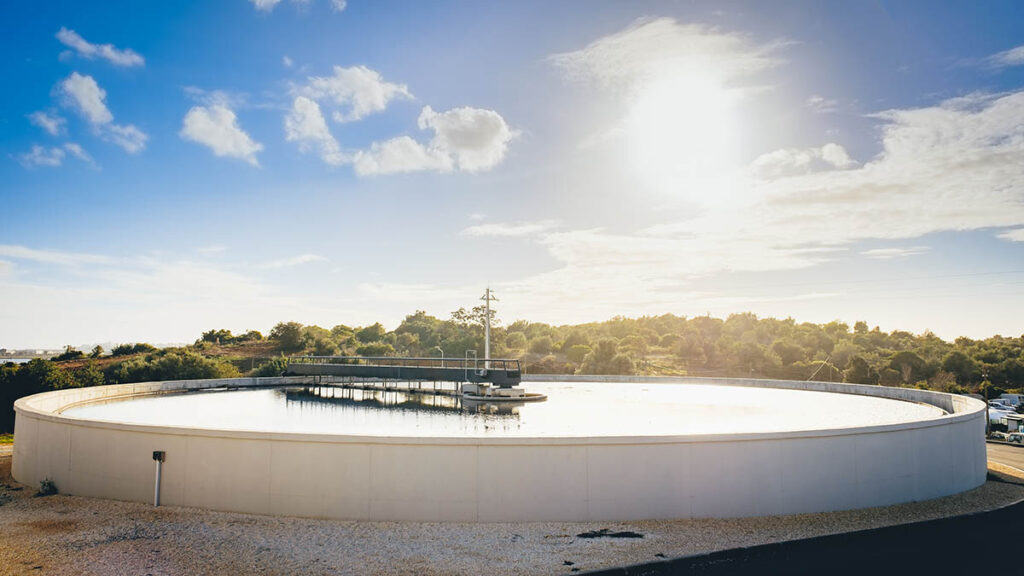The company Águas do Algarve SA launched a Public Tender for the construction of a Solar Sludge Drying Plant at the Waste Water Treatment Plant (WWTP) in Vila Real de Santo António, in order to reduce the volume and quantity of final sludge to be transported for recovery and/or landfill. The project represents an investment of 2,2 million euros.
The company adds that it has adopted the "Design-Construction model", which involves the preparation of the execution project by the contractor.
In a press release, AdA explains that "sludge is an inevitable product resulting from the treatment of wastewater".
The WWTP of Vila Real de Santo António, which treats effluents from the localities of the Fábrica, Altura, Manta Rota, Monte Gordo, Junqueira and Casto Marim, «as a result of the treatment process, it produces around 3600 tonnes of sludge annually, this volume representing an annual cost of around 121.000 euros to be sent to a final destination with an average dry matter content of 21 %'.
However, «given the climatic conditions of the Algarve region, namely the high number of sunny days, it is favorable to build a solar sludge drying system that allows for a significantly higher sicity index [dryness] and consequently to obtain if a reduction in the volume, weight and cost of sending the sludge produced in the WWTP to the final destination”.
The design/construction contract, which has a total completion period of 355 days, aims to "complement the solid phase of the treatment system at the Vila Real de Santo António WWTP, adding a new stage of solar drying of the sludge produced".
The company Águas do Algarve adds that, «on an environmental level, this project has added value, ensuring both a better quality of the sludge produced and a reduction in the number of transports necessary to send the sludge to its final destination, with all positive consequences inherent in this situation'.
The treatment system of the VRSA WWTP was designed to receive effluents from the locations of the Factory, Altura, Manta Rota, Monte Gordo, Junqueira and Casto Marim, conducted through an interceptor lift system, made up of 14 lifts 33 km long, of which 18 km correspond to lift ducts and 15 km to gravity collectors.
With its construction and entry into operation in 2009, it was possible to increase the area previously served in the municipalities of VRSA and Castro Marim and deactivate the WWTP in Manta Rota, Altura and Castro Marim.
The facility has the capacity to treat 20.965 m3/day, corresponding to a maximum population of 58.233 equivalent inhabitants.
The contract for the solar sludge drying plant at the Vila Real de Santo António WWTP consists of:
>Construction of a kiln for drying the sludge including a transport system for the dewatered sludge to the kiln, a kiln removal system and transport to the galley of
storage;
>>Weighing scale;
>>Integration of the installation in AdA's remote sanitation management system.
Sludge produced in WWTP
The sewage sludge produced in the WWTP, which carries out the treatment of urban effluents, results mainly from the excess biomass that is formed during the process of removal of organic matter and other nutrients (secondary sludge), which may also form primary sludge in the WWTP that have primary decantation.
The sludges are thickened, gravitationally or mechanically, and mechanically dehydrated, except in small installations that have drying beds, to sicity values of about 20% DM. The sludge is then temporarily stored in silos or containers until collected by licensed operators.
Sewage sludge is, therefore, a by-product of the WWTP, being classified as waste with the code LER 19 08 05 – Sludge from urban wastewater treatment.
Sludges are generally not sanitized, being collected, transported and sent for temporary storage or for direct recovery by composting, before being applied to agricultural soils. The sludge can also be landfilled.



















Comments